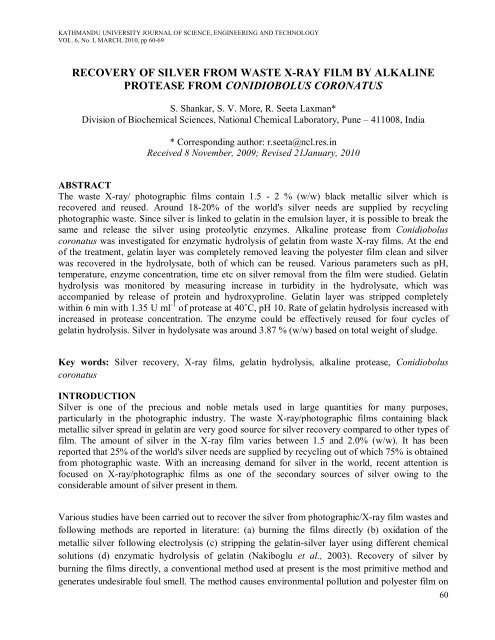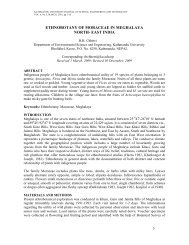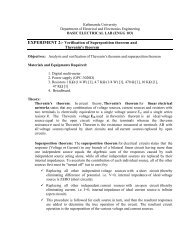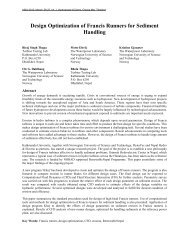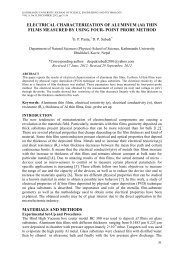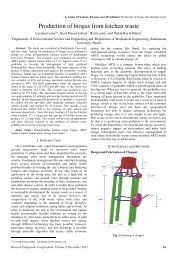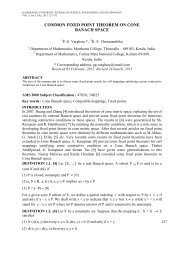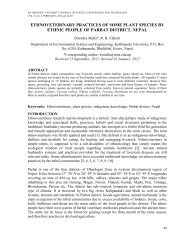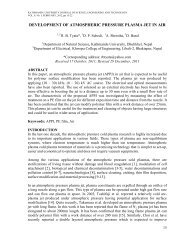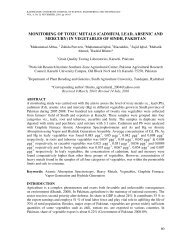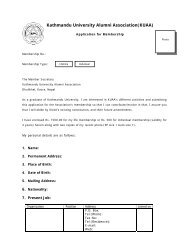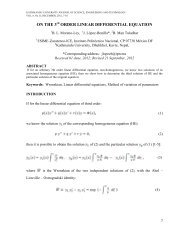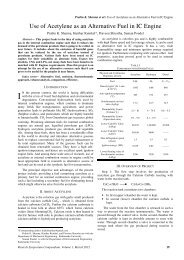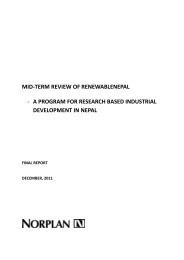Recovery of silver from waste x-ray film by alkaline protease
Recovery of silver from waste x-ray film by alkaline protease
Recovery of silver from waste x-ray film by alkaline protease
- No tags were found...
Create successful ePaper yourself
Turn your PDF publications into a flip-book with our unique Google optimized e-Paper software.
KATHMANDU UNIVERSITY JOURNAL OF SCIENCE, ENGINEERING AND TECHNOLOGYVOL. 6, No. I, MARCH, 2010, pp 60-69RECOVERY OF SILVER FROM WASTE X-RAY FILM BY ALKALINEPROTEASE FROM CONIDIOBOLUS CORONATUSS. Shankar, S. V. More, R. Seeta Laxman*Division <strong>of</strong> Biochemical Sciences, National Chemical Laboratory, Pune – 411008, India* Corresponding author: r.seeta@ncl.res.inReceived 8 November, 2009; Revised 21January, 2010ABSTRACTThe <strong>waste</strong> X-<strong>ray</strong>/ photographic <strong>film</strong>s contain 1.5 - 2 % (w/w) black metallic <strong>silver</strong> which isrecovered and reused. Around 18-20% <strong>of</strong> the world's <strong>silver</strong> needs are supplied <strong>by</strong> recyclingphotographic <strong>waste</strong>. Since <strong>silver</strong> is linked to gelatin in the emulsion layer, it is possible to break thesame and release the <strong>silver</strong> using proteolytic enzymes. Alkaline <strong>protease</strong> <strong>from</strong> Conidioboluscoronatus was investigated for enzymatic hydrolysis <strong>of</strong> gelatin <strong>from</strong> <strong>waste</strong> X-<strong>ray</strong> <strong>film</strong>s. At the end<strong>of</strong> the treatment, gelatin layer was completely removed leaving the polyester <strong>film</strong> clean and <strong>silver</strong>was recovered in the hydrolysate, both <strong>of</strong> which can be reused. Various parameters such as pH,temperature, enzyme concentration, time etc on <strong>silver</strong> removal <strong>from</strong> the <strong>film</strong> were studied. Gelatinhydrolysis was monitored <strong>by</strong> measuring increase in turbidity in the hydrolysate, which wasaccompanied <strong>by</strong> release <strong>of</strong> protein and hydroxyproline. Gelatin layer was stripped completelywithin 6 min with 1.35 U ml -1 <strong>of</strong> <strong>protease</strong> at 40˚C, pH 10. Rate <strong>of</strong> gelatin hydrolysis increased withincreased in <strong>protease</strong> concentration. The enzyme could be effectively reused for four cycles <strong>of</strong>gelatin hydrolysis. Silver in hydolysate was around 3.87 % (w/w) based on total weight <strong>of</strong> sludge.Key words: Silver recovery, X-<strong>ray</strong> <strong>film</strong>s, gelatin hydrolysis, <strong>alkaline</strong> <strong>protease</strong>, ConidioboluscoronatusINTRODUCTIONSilver is one <strong>of</strong> the precious and noble metals used in large quantities for many purposes,particularly in the photographic industry. The <strong>waste</strong> X-<strong>ray</strong>/photographic <strong>film</strong>s containing blackmetallic <strong>silver</strong> spread in gelatin are very good source for <strong>silver</strong> recovery compared to other types <strong>of</strong><strong>film</strong>. The amount <strong>of</strong> <strong>silver</strong> in the X-<strong>ray</strong> <strong>film</strong> varies between 1.5 and 2.0% (w/w). It has beenreported that 25% <strong>of</strong> the world's <strong>silver</strong> needs are supplied <strong>by</strong> recycling out <strong>of</strong> which 75% is obtained<strong>from</strong> photographic <strong>waste</strong>. With an increasing demand for <strong>silver</strong> in the world, recent attention isfocused on X-<strong>ray</strong>/photographic <strong>film</strong>s as one <strong>of</strong> the secondary sources <strong>of</strong> <strong>silver</strong> owing to theconsiderable amount <strong>of</strong> <strong>silver</strong> present in them.Various studies have been carried out to recover the <strong>silver</strong> <strong>from</strong> photographic/X-<strong>ray</strong> <strong>film</strong> <strong>waste</strong>s andfollowing methods are reported in literature: (a) burning the <strong>film</strong>s directly (b) oxidation <strong>of</strong> themetallic <strong>silver</strong> following electrolysis (c) stripping the gelatin-<strong>silver</strong> layer using different chemicalsolutions (d) enzymatic hydrolysis <strong>of</strong> gelatin (Nakiboglu et al., 2003). <strong>Recovery</strong> <strong>of</strong> <strong>silver</strong> <strong>by</strong>burning the <strong>film</strong>s directly, a conventional method used at present is the most primitive method andgenerates undesirable foul smell. The method causes environmental pollution and polyester <strong>film</strong> on60
KATHMANDU UNIVERSITY JOURNAL OF SCIENCE, ENGINEERING AND TECHNOLOGYVOL. 6, No. I, MARCH, 2010, pp 60-69which emulsion <strong>of</strong> <strong>silver</strong> and gelatin is coated cannot be recovered. Stripping the gelatin-<strong>silver</strong> layer<strong>by</strong> chemical methods using ammonium thiosulphate, sodium thiosulphate, nitric acid or reagentssuch as sodium cyanide, NaOH, nitric acid or organic compounds cause environmental hazards andare either time consuming or very expensive while the use <strong>of</strong> NaOH at high temperatures poses aserious industrial safety problem. For this reason, the methods applied to recover <strong>silver</strong> <strong>from</strong> X-<strong>ray</strong>/photographic <strong>waste</strong> should be cost effective and have minimal impact on environment andenzyme based methods can be an alternative option.Gelatin is a protein <strong>from</strong> animal collagen which contains a large number <strong>of</strong> glycine, proline and 4-hydroxyproline residues. Since the emulsion layer on X-<strong>ray</strong> <strong>film</strong> contains <strong>silver</strong> and gelatin, it ispossible to break down the gelatin layer using <strong>protease</strong>s and release the <strong>silver</strong> (Nakiboglu et al.,2001). The enzymatic hydrolysis <strong>of</strong> the gelatin layers on the X-<strong>ray</strong> <strong>film</strong> enables not only therecovery <strong>of</strong> the <strong>silver</strong>, but also the polyester base which can be recycled. Hence in recent years,enzymatic methods using microbial <strong>protease</strong>s are being explored as alternatives to the burning andoxidation methods <strong>of</strong> <strong>silver</strong> recovery <strong>from</strong> photographic/X-<strong>ray</strong> <strong>film</strong>s (Singh et al., 1999; Ingale etal., 2002; Nakiboglu et al., 2003; Masui et al., 2004). Basically enzymatic processes are morespecific and remove gelatin layer <strong>from</strong> X-<strong>ray</strong> <strong>film</strong> in few minutes without damaging the polyester<strong>film</strong> base. Gelatin molecules are cross linked with hardners and it is difficult for the usual <strong>protease</strong>sto degrade it in a short time. Most <strong>of</strong> the <strong>protease</strong>s used so far for <strong>silver</strong> recovery are <strong>of</strong> bacterialorigin and there is only one report on use <strong>of</strong> fungal <strong>alkaline</strong> <strong>protease</strong>.Conidiobolus coronatus ATCC PTA-4132 secretes high levels <strong>of</strong> <strong>alkaline</strong> <strong>protease</strong> in 2-3 days.Optimization and scale up <strong>of</strong> production <strong>of</strong> <strong>alkaline</strong> <strong>protease</strong> in fermentor is reported earlier(Laxman et al., 2005). This enzyme has been extensively evaluated in tanneries and findsapplications in pre-tanning operations in leather manufacture (Laxman et al., 2007). The objective<strong>of</strong> the present work is to remove the gelatin layer <strong>from</strong> <strong>waste</strong> X-<strong>ray</strong> <strong>film</strong> and recover both <strong>silver</strong> aswell as the polyester <strong>film</strong> in an eco-friendly manner. The present paper describes the use <strong>of</strong> <strong>alkaline</strong><strong>protease</strong> <strong>from</strong> Conidiobolus coronatus for <strong>silver</strong> removal <strong>from</strong> X-<strong>ray</strong>s <strong>film</strong>s and its recovery forreuse.MATERIALS AND METHODSMalt extract, yeast extract and peptone were obtained <strong>from</strong> Hi Media Chemicals, India.Hammerstein casein was obtained <strong>from</strong> Sisco Research Laboratories, India. All other chemicalswere <strong>of</strong> analytical grade. X-<strong>ray</strong> <strong>film</strong>s were obtained <strong>from</strong> local medical center.Cultural conditions and production <strong>of</strong> enzymeThe organism was routinely sub-cultured and maintained on MGYP (malt extract-3; glucose-10;yeast extract -3; peptone -5, all ingredients in g 1 -1 ) agar slants and preserved between 15 to 28˚C.Enzyme production was carried out as described earlier in 500 ml Erlenmeyer flasks containing 100ml medium (Laxman et al., 2005). After 72 h <strong>of</strong> growth in MGYP broth containing 2% (w/v)soyabean meal, the cell-free supernatant (obtained <strong>by</strong> centrifugation at 8000 × g, 4˚C, 20 min) wasused as source <strong>of</strong> enzyme for <strong>silver</strong> recovery studies.61
KATHMANDU UNIVERSITY JOURNAL OF SCIENCE, ENGINEERING AND TECHNOLOGYVOL. 6, No. I, MARCH, 2010, pp 60-69Determination <strong>of</strong> <strong>alkaline</strong> <strong>protease</strong> activityProtease activity was determined as described earlier at 40˚C, pH 10 (Laxman et al., 2005).Hydrolysis <strong>of</strong> gelatin and release <strong>of</strong> <strong>silver</strong>Used X-<strong>ray</strong> <strong>film</strong>s were washed with distilled water and wiped with cotton impregnated withethanol. The washed <strong>film</strong> was dried in an oven at 40˚C for 30 min. One g <strong>of</strong> X-<strong>ray</strong> <strong>film</strong> (cut into 2 x2 cm pieces) was then incubated with 10 ml <strong>of</strong> crude <strong>protease</strong> (such that the <strong>film</strong> is completelyimmersed in the solution) at 40˚C, pH 10 in a water bath with continuous shaking. Turbidity <strong>of</strong> thereaction mixture (hydrolysate) increased with time (as the hydrolysis progressed) and no furtherincrease in turbidity was observed when hydrolysis was complete. Hence, progress <strong>of</strong> hydrolysis i.e.turbidity was monitored <strong>by</strong> measuring the absorbance at 660 nm. Samples were removed at 1 minintervals and time required for complete removal <strong>of</strong> gelatin layer was noted.Effect <strong>of</strong> temperature & pHHydrolysis was carried out as described earlier with 1g <strong>film</strong> in 10 ml <strong>of</strong> crude enzyme having<strong>protease</strong> activity <strong>of</strong> 1.35 U ml -1 . For determination <strong>of</strong> optimum temperature, gelatin hydrolysis wascarried out at pH 10 and temperatures ranging <strong>from</strong> 30 to 60˚C. Optimum pH for hydrolysis <strong>of</strong>gelatin was studied at 40˚C and pH values ranging <strong>from</strong> 7 to 11.Effect <strong>of</strong> enzyme concentration & time course <strong>of</strong> hydrolysisEffect <strong>of</strong> enzyme concentration on hydrolysis <strong>of</strong> gelatin was measured <strong>by</strong> incubating 1 g <strong>film</strong> (2 x2 cm pieces) with 10 ml <strong>of</strong> enzyme at 40˚C and pH 10 and <strong>protease</strong> activities ranging <strong>from</strong> 0 to 2.7U ml -1 . Samples were removed at an interval <strong>of</strong> 5 min until the gelatin layer was completelystripped <strong>of</strong>f and time required for complete removal was noted. Extent <strong>of</strong> hydrolysis was expressedas percentage compared to the highest absorbance which was taken as 100%. For time course <strong>of</strong>gelatin removal, the <strong>film</strong> was incubated with 10 ml <strong>of</strong> 0.9 U ml -1 <strong>of</strong> <strong>protease</strong> at 40˚C and pH 10.Samples were removed at 1 min intervals and increase in turbidity due to gelatin removal wasmeasured at 660 nm.Release <strong>of</strong> protein & hydroxyproline during hydrolysisHydroxyproline and protein released during gelatin hydrolysis was monitored. Protein wasestimated according to Lowry et al. (1951) with bovine serum albumin (BSA) as the standard.Hydroxyproline was estimated <strong>by</strong> the method <strong>of</strong> Neuman and Logan (1950). The purple colourformed was measured at 540 nm and hydroxyproline content was calculated <strong>from</strong> a standard curve.Reuse <strong>of</strong> enzyme for hydrolysisReuse <strong>of</strong> enzyme for gelatin hydrolysis and <strong>silver</strong> removal was carried out at three enzymeconcentrations. One g (2 x 2 cm pieces) <strong>of</strong> X-<strong>ray</strong> <strong>film</strong> was incubated at 40˚C, pH 10 with 10 ml <strong>of</strong>62
KATHMANDU UNIVERSITY JOURNAL OF SCIENCE, ENGINEERING AND TECHNOLOGYVOL. 6, No. I, MARCH, 2010, pp 60-69<strong>protease</strong> having 0.18, 0.45 and 0.9 U ml -1 . After complete removal <strong>of</strong> gelatin, old X-<strong>ray</strong> <strong>film</strong> wasremoved and fresh <strong>film</strong> (1 g) was added to the same enzyme solution and incubation continued tillcomplete removal <strong>of</strong> gelatin was observed. The process was repeated till gelatin hydrolysis stopped.Time required for complete gelatin removal in each case was noted.<strong>Recovery</strong> <strong>of</strong> <strong>silver</strong>Five grams <strong>of</strong> X-<strong>ray</strong> <strong>film</strong> was incubated with 50 ml <strong>of</strong> 1.35 U ml -1 <strong>of</strong> <strong>protease</strong> at 40˚C, pH 10, and200 rpm on a rotary shaker. After complete gelatin removal, reaction slurry containing gelatin and<strong>silver</strong> was acid digested and used for analysis <strong>of</strong> metals <strong>by</strong> AAS-Chemito-201.RESULTS AND DISCUSSIONEffect <strong>of</strong> temperature & pHEffect <strong>of</strong> temperature and pH was studied at fixed <strong>protease</strong> concentration <strong>of</strong> 1.35 U ml -1 . Gelatinhydrolysis increased with increase in temperature and reached a maximum at 40˚C and decreasedthereafter (Fig.1). Removal was complete within 6 min at 40˚C, while at higher temperatures it wasincomplete possibly due to inactivation <strong>of</strong> <strong>protease</strong>. No hydrolysis observed at lower temperatures.Gelatin removal was observed over a wide pH range <strong>of</strong> 7 to 11 with maximum hydrolysis at pH 10(Fig. 2). Hydrolysis was complete within 6 min at pH 10 while it was complete in 7 min at other pHvalues. Singh et al. (1999) reported gelatin hydrolysis <strong>of</strong> X-<strong>ray</strong> <strong>film</strong> <strong>by</strong> a bacterial <strong>protease</strong> within 8min at 60˚C, pH 11-12. Degradation took longer time at pH 7-10 or at 30˚C and 50˚C. Completehydrolysis was achieved <strong>by</strong> Conidiobolous coronatus <strong>protease</strong> at 40˚C where less heating energywould be required. Ishikawa et al. (1993) showed that the time required for complete gelatinhydrolysis <strong>of</strong> X-<strong>ray</strong> <strong>film</strong> was the shortest and the rate <strong>of</strong> hydrolysis was highest at pH 10.5 <strong>by</strong><strong>protease</strong> <strong>from</strong> Bacillus sp. B21-2. Masui et al. (1999) reported 60 min for the complete hydrolysis<strong>of</strong> gelatin layer at 50˚C, pH 10.5. Nakiboglu et al. (2001) reported that the <strong>protease</strong> <strong>from</strong> Bacillussubtilis ATCC 6633 takes less than 15 min to decompose the gelatin layers at 50˚C while theenzyme was rapidly inactivated at 60˚C. As gelatin hydrolysis was optimum at 40˚C and pH 10, allfurther the experiments were carried out under these conditions.63
KATHMANDU UNIVERSITY JOURNAL OF SCIENCE, ENGINEERING AND TECHNOLOGYVOL. 6, No. I, MARCH, 2010, pp 60-694Absorbance (660 nm )321020 30 40 50 60Temp (˚C)Fig. 1: Effect <strong>of</strong> temperature on gelatin hydrolysis: 0 min (x), 4 min ( ), 5 min ( ), 6 min ( ), 7min ( ) and 8 min ( ).4Absorbance (660 nm )32106 8 10 12pHFig. 2: Effect <strong>of</strong> pH on gelatin hydrolysis: 0 min ( ), 4 min ( ), 5 min ( ), 6 min (x) and 7 min ( ).Effect <strong>of</strong> enzyme concentrationEffect <strong>of</strong> <strong>protease</strong> concentration on hydrolysis <strong>of</strong> gelatin was studied at 40˚C and pH 10. Higher theenzyme concentration, greater was the hydrolysis rate. It was observed that gelatin layer wasstripped completely within 10 min when enzyme concentration ranged <strong>from</strong> 0.81 to 2.7 U ml -1 (Fig.3).64
KATHMANDU UNIVERSITY JOURNAL OF SCIENCE, ENGINEERING AND TECHNOLOGYVOL. 6, No. I, MARCH, 2010, pp 60-69120100Hydrolysis (%)8060402000 10 20 30 40Time (min)Fig. 3: Effect <strong>of</strong> enzyme concentration on gelatin hydrolysis: 0 U ml -1 ( ), 0.16 U ml -1 ( ), 0.32 Uml -1 ( ), 0.49 U ml -1 ( ), 0.81 U ml -1 ( ), 1.35 U ml -1 ( ) and 2.7 U ml -1 (x).Hydrolysis percentages were 13, 70 and 90 for 0.81, 1.35 and 2.7 U ml -1 respectively at the end <strong>of</strong> 5min. (Hydrolysis would have been complete in 6 minutes itself with 1.35 and 2.7 U ml -1 but notrecorded as samples were removed at 5 min intervals). Longer incubations were required forcomplete removal <strong>of</strong> gelatin with lower enzyme concentrations. Complete gelatin removal occurredonly after 35 min with the lowest enzyme concentration <strong>of</strong> 0.16 U ml -1 . Ingale et al. (2002) reporteduse <strong>of</strong> 50 U ml -1 <strong>of</strong> <strong>protease</strong> <strong>from</strong> Basidiobolus for complete hydrolysis. Lower enzymesconcentrations <strong>of</strong> 10 U ml -1 required 12 min while degradation was complete within 5 min withhigher enzyme concentration <strong>of</strong> 90 U ml -1 . Masui et al. (2004) reported that the time required forcomplete gelatin hydrolysis <strong>from</strong> X-<strong>ray</strong> <strong>film</strong> <strong>by</strong> Bacillus B21-2 <strong>protease</strong> (at the enzyme to <strong>film</strong>ration <strong>of</strong> 5.6 x 10 -7 g cm -3 ) to be temperature dependent and was between 8-10 min at 50˚C , pH10.5. Singh et al. (1999) reported complete gelatin degradation in 24 min <strong>by</strong> 10 U ml -1 <strong>of</strong> <strong>alkaline</strong><strong>protease</strong> while 8-12 min was required when the enzyme concentration was increased to 25-100 Uml -1 .Time course <strong>of</strong> hydrolysis and release <strong>of</strong> protein and hydroxyprolineNearly more than 80-90% <strong>of</strong> stripping <strong>of</strong>f <strong>of</strong> gelatin <strong>from</strong> X-<strong>ray</strong> <strong>film</strong> was achieved in 6-7 min at pH10 and 40˚C. Protein and hydroxyproline in the hydrolysate increased with progress <strong>of</strong> gelatinremoval and the ratio <strong>of</strong> hydroxyproline to protein was nearly constant (Fig.4a). After completestripping <strong>of</strong>f <strong>of</strong> gelatin, hydroxyproline and protein concentrations ranged between 40-45 µg ml -1and 160-170 µg ml -1 respectively. In all the experimental runs except in case <strong>of</strong> high enzymeconcentrations, lag periods were observed when the hydrolysis was very slow. This could be due toslow adsorption <strong>of</strong> <strong>protease</strong> on to the surface. With time, the hydrolysis rates increased as a result <strong>of</strong>the increase in the amount <strong>of</strong> the enzyme adsorbed on the gelatin surface (Fig.4b).65
KATHMANDU UNIVERSITY JOURNAL OF SCIENCE, ENGINEERING AND TECHNOLOGYVOL. 6, No. I, MARCH, 2010, pp 60-692004Protein (µg ml -1 ) Hydroxyproline (µgml -1 )160120804000 5 10 15 20Time (min)3210Absorbance 660 nmFig. 4a : Time course <strong>of</strong> gelatin hydrolysis: hydrolysis ( ), protein ( ) and hydroxyproline ( )released. Closed symbols- 2.7 U ml -1 ; open symbols-1.35 U ml -1 .Masui et al. (1999) studied decomposition <strong>of</strong> gelatin <strong>by</strong> <strong>protease</strong>s <strong>from</strong> alkalophilic Bacillus and itsthree mutants. They reported 0-17% gelatin degradation in 30 min depending on the enzyme (wildor mutants) while complete degradation was achieved in 45 min for all the enzymes tested atconcentration <strong>of</strong> 5 U ml -1 and 50˚C, pH 10.5. They observed that swelling <strong>of</strong> gelatin on the X-<strong>ray</strong><strong>film</strong> takes place during initial 30 min after which hydrolysis proceeds rapidly <strong>from</strong> 30-45 min.Fujiwara et al. (1989) reported complete breakdown <strong>of</strong> gelatin <strong>by</strong> an <strong>alkaline</strong> <strong>protease</strong> <strong>from</strong>alkalophilic Bacillus sp. B21-2 in 8 min at 40˚C, pH 10.5 and at enzyme concentration <strong>of</strong> 100 U ml -1 while all the <strong>alkaline</strong> <strong>protease</strong>s <strong>from</strong> the neutrophile Bacillus subtilis took more than 20 min to act.Subtilisin BPN, took 30 min to decompose the gelatin layer at 50-60˚C while treatment timeincreased to 120-180 min at 30˚C.66
KATHMANDU UNIVERSITY JOURNAL OF SCIENCE, ENGINEERING AND TECHNOLOGYVOL. 6, No. I, MARCH, 2010, pp 60-6940Hydrolysis rate(Percentage min -1 )30201001 2 3 4 5 6 7 8Incubation Time (min)Fig. 4b : Rate <strong>of</strong> gelatin hydrolysis during the time course.Reuse <strong>of</strong> enzyme for gelatin hydrolysis was evaluated at 40˚C, pH 10 and with <strong>protease</strong>concentrations varying <strong>from</strong> 0.18 to 0.9 U ml -1 in a water bath with continuous shaking until thegelatin layer was completely removed. With 0.9 U ml -1 , <strong>protease</strong> could be reused up to 4 times(Table 1).Table 1: Reuse <strong>of</strong> enzyme for gelatin hydrolysis <strong>from</strong> <strong>waste</strong> X-<strong>ray</strong> <strong>film</strong>Protease (U ml -1 )Time required for complete gelatin removal (min)Cycle 1 Cycle 2 Cycle 3 Cycle 40.18 40 70 - -0.45 8 17 20 -0.90 6 10 14 20- Incomplete removal67
KATHMANDU UNIVERSITY JOURNAL OF SCIENCE, ENGINEERING AND TECHNOLOGYVOL. 6, No. I, MARCH, 2010, pp 60-69Lowering the enzyme concentration resulted in longer reaction time for complete gelatin removaland also reduced the number <strong>of</strong> recycles. Repeated treatment <strong>of</strong> X-<strong>ray</strong> <strong>film</strong>s for every 60 min wascarried out at 50˚C with 5-20 U ml -1 <strong>of</strong> <strong>protease</strong> using wild type and A187P enzyme (Masui et al.,1999). They reported that the treatment time increased after every reuse <strong>of</strong> enzyme. At an enzymeconcentration <strong>of</strong> 5 U ml -1 , first decomposition was complete in 60 min while 2 nd use required morethan 2 h. increasing the enzyme concentration, resulted in increased number <strong>of</strong> reuses (Masui et al.,1999).<strong>Recovery</strong> <strong>of</strong> <strong>silver</strong>Treatment <strong>of</strong> X-<strong>ray</strong> <strong>film</strong>s with <strong>protease</strong> resulted in the sliver bound with gelatin being stripped <strong>of</strong>fin to the reaction mixture and clean plastic <strong>film</strong> was recovered. The loss in weight after thetreatment was around 5% (w/w) based on initial weight <strong>of</strong> the <strong>film</strong>. The <strong>silver</strong> content in thehydrolysate was determined <strong>by</strong> atomic absorption and corresponded to 3.87% (w/w) <strong>of</strong> the solidsludge and 0.2% (w/w) based on the weight <strong>of</strong> the X-<strong>ray</strong> <strong>film</strong>. Ingale et al. (2002) reported 0.1%(w/w) <strong>of</strong> <strong>silver</strong> recovery <strong>from</strong> photographic <strong>film</strong>. Apart <strong>from</strong> Ag, other metals in the slurry werealso analyzed and only Mg was detected in trace amounts while metals like Fe, Cr, Cu, Al, Pb andNi were not detected. Silver <strong>from</strong> the hydrolysate was recovered either as metallic <strong>silver</strong> or as <strong>silver</strong>chloride. Silver chloride can be used to make photographic paper, as pottery glazes, inphotochromic lenses, in stained glass manufacture, in bandages and wound healing products.AcknowledgementsShiv Shankar is grateful to the Council <strong>of</strong> Scientific and Industrial Research (CSIR) for the CSIR-JRF Fellowship.REFERENCES1. Fujiwara N, Tsumiya T, Katada T, Hosobuchi T & Yamamoto K, 1989. Continuousrecovery <strong>of</strong> <strong>silver</strong> <strong>from</strong> used X-<strong>ray</strong> <strong>film</strong>s using a proteolytic enzyme. Process Biochemistry,24, 155-156.2. Ingale S S, Rele M V & Srinivasan M C, 2002. Alkaline <strong>protease</strong> production <strong>by</strong>Basidiobolus (N.C.L. 97.1.1): effect <strong>of</strong> ‘darmform’ morphogenesis and cultural conditionson enzyme production and preliminary enzyme characterization. World Journal <strong>of</strong>Microbiology and Biotechnology, 18, 403-408.3. Ishikawa H, Ishimi K, Sugiura M, Sowa A & Fujiwara N, 1993. Kinetics and mechanism <strong>of</strong>enzymatic hydrolysis <strong>of</strong> gelatin layers <strong>of</strong> X-<strong>ray</strong> <strong>film</strong> and release <strong>of</strong> <strong>silver</strong> particles. Journal<strong>of</strong> Fermentation and Bioengineering, 76, 300-305.4. Laxman R S, More S V, Rele M V, Rao B S, Jogdand V V, Rao M, Deshpande V V, NaiduR B, Manikandan P, Ashok Kumar D, Kanagraj J, Ramalingam S, Samivelu N &Puvannakrishnan R 2007. US Patent No. 7186546.68
KATHMANDU UNIVERSITY JOURNAL OF SCIENCE, ENGINEERING AND TECHNOLOGYVOL. 6, No. I, MARCH, 2010, pp 60-695. Laxman R S, Sonawane A P, More S V, Rao B S, Rele M V, Jogdand V V, Deshpande V V& Rao M B, 2005. Optimization and scale up <strong>of</strong> production <strong>of</strong> <strong>alkaline</strong> <strong>protease</strong> <strong>from</strong>Conidiobolus coronatus. Process Biochemistry, 40, 3152-3158.6. Lowry O H, Rosebrough N J, Farr A L & Randall R J, 1951. Protein measurement with thefolin phenol reagent. Journal <strong>of</strong> Biological Chemistry, 193, 265-275.7. Masui A, Fujiwara N, Takagi M & Imanaka T, 1999. Feasibility study for decomposition <strong>of</strong>gelatin layers on X-<strong>ray</strong> <strong>film</strong>s <strong>by</strong> thermostable <strong>alkaline</strong> <strong>protease</strong> <strong>from</strong> alkaliphilic Bacillus sp.Biotechnological Techniques, 13, 813-815.8. Masui A, Yasuda M, Fujiwara N & Ishikawa H, 2004. Enzymatic hydrolysis <strong>of</strong> gelatin layeron used lith <strong>film</strong> using thermostable <strong>alkaline</strong> <strong>protease</strong> for the recovery <strong>of</strong> <strong>silver</strong> and PET<strong>film</strong>. Biotechnology Progress, 20, 1267-1269.9. Nakiboglu N, Toscali D & Nisli G, 2003. A novel <strong>silver</strong> recovery method <strong>from</strong> <strong>waste</strong>photographic <strong>film</strong>s with NaOH stripping. Turk Journal <strong>of</strong> Chemistry, 27, 127-133.10. Nakiboglu N, Toscali D & Yasa I, 2001. Silver recovery <strong>from</strong> <strong>waste</strong> photographic <strong>film</strong>s <strong>by</strong>an enzymatic method. Turk Journal <strong>of</strong> Chemistry, 25, 349-353.11. Neuman R E & Logan M, 1950. The determination <strong>of</strong> hydroxyproline. Journal <strong>of</strong> BiologicalChemistry, 184, 299-306.12. Singh J, Vohra R M & Sahoo D K, 1999. Alkaline <strong>protease</strong> <strong>from</strong> a new obligate alkalophilicisolate <strong>of</strong> Bacillus sphaericus. Biotechnology Letter, 21, 921-924.69


